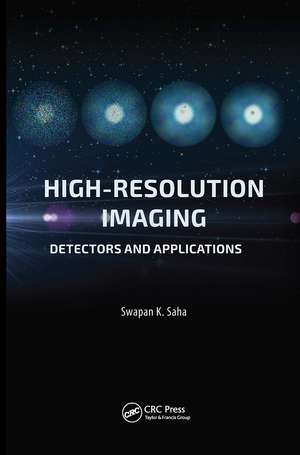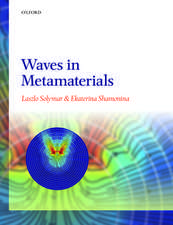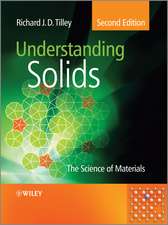High Resolution Imaging: Detectors and Applications
Editat de Swapan K. Sahaen Limba Engleză Hardback – 28 ian 2015
One of the fastest growing applications is signal sensing, especially wavefront sensing for adaptive optics and fringe tracking for interferometry, which is important for long-baseline optical interferometry. The coherence time of the atmosphere is a highly variable parameter. Depending upon the high velocity wind, it varies from <1 ms to 0.1 s. The exposure times are to be selected accordingly, to maximize the signal-to-noise ratio, as well as to freeze the fringe pattern. A large-format photon-counting system, which is an essential tool in the application of optical interferometric imaging, allows accurate photon centroiding and provides the dynamic range needed for measurements of source characteristics. The advent of high-quantum efficiency photon-counting systems vastly increases the sensitivity of high-resolution imaging techniques. Such systems raise the hope of making diffraction-limited images of objects as faint as ~15–16 m_v (visual magnitude).
This book deals with the fundamentals of the important aspects of high-resolution imaging, such as electromagnetic radiations, particularly, optical wavelengths and their distortions due to optical elements and Earth’s atmosphere while passing through a detector; semiconductor physics; lasers; fiber optics; photon-detection process; photodetectors; charge-transfer devices; photon-counting devices in visible wavelength; radiation detectors in infrared wavelengths; and detecting systems for high energies.
Preț: 910.18 lei
Preț vechi: 1109.98 lei
-18% Nou
Puncte Express: 1365
Preț estimativ în valută:
174.21€ • 181.18$ • 145.99£
174.21€ • 181.18$ • 145.99£
Carte tipărită la comandă
Livrare economică 13-27 martie
Preluare comenzi: 021 569.72.76
Specificații
ISBN-13: 9789814613279
ISBN-10: 9814613274
Pagini: 600
Ilustrații: 124 Illustrations, black and white
Dimensiuni: 156 x 234 x 33 mm
Greutate: 0.99 kg
Ediția:1
Editura: Jenny Stanford Publishing
Colecția Jenny Stanford Publishing
ISBN-10: 9814613274
Pagini: 600
Ilustrații: 124 Illustrations, black and white
Dimensiuni: 156 x 234 x 33 mm
Greutate: 0.99 kg
Ediția:1
Editura: Jenny Stanford Publishing
Colecția Jenny Stanford Publishing
Public țintă
Academic and PostgraduateCuprins
Introducing topological insulators: Mind the time reversal. Two-dimensional topological insulators. Two-dimensional topological insulators in quantizing magnetic fields. Three-dimensional topological insulators. Unconventional superconductivity and Majorana fermions in topological insulators.
Recenzii
"This unique book describes the current evolution of astronomical instruments in the way of high-resolution observations. The book nicely specifies the special requirements for detectors, which must respond fast for mitigating the degrading effect of the atmospheric turbulence. It should be of interest to professional and amateur astronomers, particularly those who may want to attempt forms of high-resolution observation, some of which are becoming widely accessible."
—Antoine Labeyrie, Emeritus Professor, Collège de France, France
"Prof. Saha has done a splendid job by presenting a succinct description of the principles and applications of radiation detectors used for high-resolution imaging in visible and infrared astronomy. The scope of the book, however, extends to all areas of high-resolution imaging, and the book will be a welcome addition to the library of anyone interested in learning about the state of the art in the field."
—Prof. Lakshminarayan Hazra, University of Calcutta, India
"In the present volume, Saha has used his expertise in instrumentation and data analysis to expand his horizons to a wider range of high-resolution imaging techniques, essential characteristics of detectors and control electronics, and other wavelength ranges and kinds of astronomical sources. This book will be a valuable resource for astronomers and students involved in the design of modern instrumentation and attempting to take and make use of data with instrumentation that they did not design."
—Prof. Virginia Trimble, University of California, Irvine, USA
—Antoine Labeyrie, Emeritus Professor, Collège de France, France
"Prof. Saha has done a splendid job by presenting a succinct description of the principles and applications of radiation detectors used for high-resolution imaging in visible and infrared astronomy. The scope of the book, however, extends to all areas of high-resolution imaging, and the book will be a welcome addition to the library of anyone interested in learning about the state of the art in the field."
—Prof. Lakshminarayan Hazra, University of Calcutta, India
"In the present volume, Saha has used his expertise in instrumentation and data analysis to expand his horizons to a wider range of high-resolution imaging techniques, essential characteristics of detectors and control electronics, and other wavelength ranges and kinds of astronomical sources. This book will be a valuable resource for astronomers and students involved in the design of modern instrumentation and attempting to take and make use of data with instrumentation that they did not design."
—Prof. Virginia Trimble, University of California, Irvine, USA
Notă biografică
Professor Swapan K. Saha has a strong interest in experimental physics, optical interferometry in particular, and has developed various instruments. He has taught observational astronomy, high-resolution imaging, aperture synthesis, adaptive optics, atmospheric science, and image processing at a couple of premiere institutes in India. Prof. Saha has delivered several invited and plenary talks at various national and international conferences and universities on these topics. Author of a few more books, he is on the editorial boards of the Asian Journal of Physics and the Journal of Optics (Springer) and has edited a book, 21st Century Astrophysics, as well as a special issue of the Asian Journal of Physics on astrophysics in 2004.
Descriere
This book deals with the fundamentals of the important aspects of high-resolution imaging, such as electromagnetic radiations, particularly, optical wavelengths and their distortions due to optical elements and Earth’s atmosphere while passing through a detector; semiconductor physics; lasers; fiber optics; photon-detection process; photodetectors; charge-transfer devices; photon-counting devices in visible wavelength; radiation detectors in infrared wavelengths; and detecting systems for high energies.











